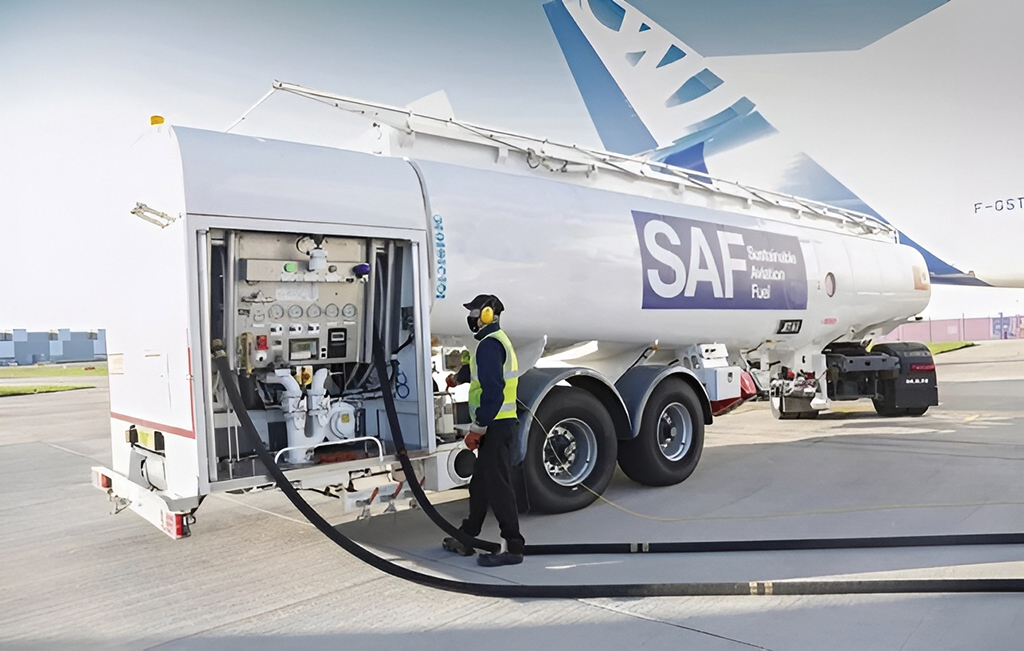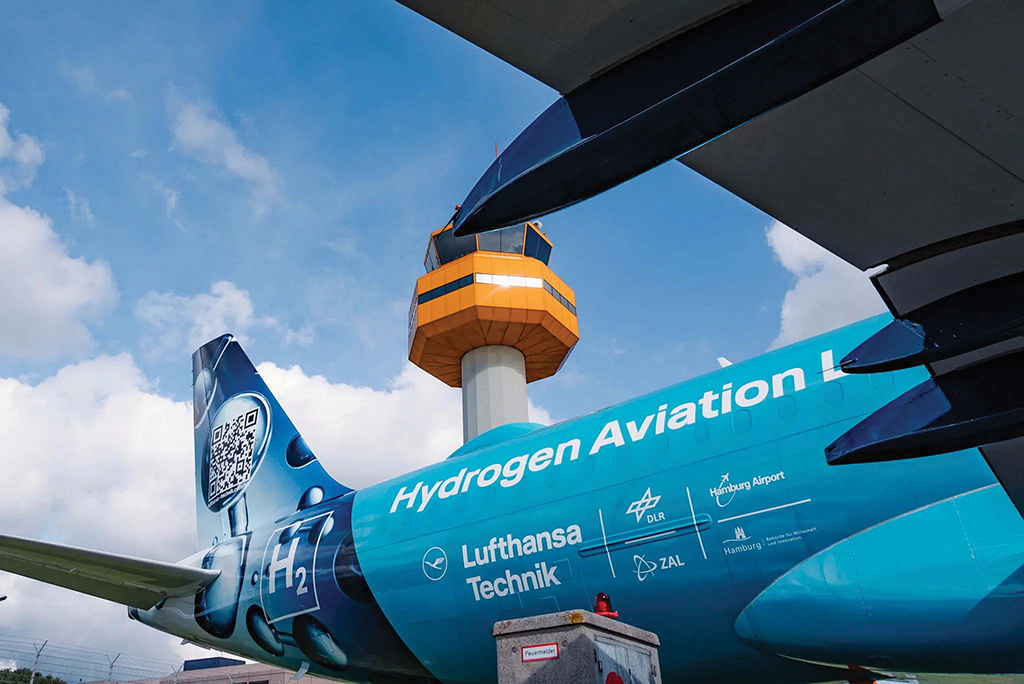
Engine maintenance may become far more complicated with greater use of SAF.
The MRO industry’s commitment to sustainability is encouraging but varied, while airlines see feedstock sustainable aviation fuels as the path of least resistance for reducing their carbon emissions. These fuels are green and compatible with existing technologies, but their use may leave MROs with new problems.
Sustainability has become a defining issue for aviation, with rising public and regulatory pressures demanding action to curb the industry’s impact on the climate. Airlines are responding by setting ambitious carbon-reduction goals, publicizing their eco initiatives both large and small, and adding sustainability sections to annual reports. But how are their MRO partners responding to airlines’ bold sustainability commitments?
Sustainability adoption across the segment appears mixed. Larger MROs with in-house airline customers have implemented a variety of environmental initiatives ranging from facility energy efficiency upgrades to optimized repair processes that reduce waste.
Derk Nieuwenhuijze, head of strategy, marketing and communication at AFI KLM E&M, says the company is making solid progress on achieving zero emissions by 2030, with a major chunk of forecast cuts to come from more efficient heating and electricity for the company’s facilities and better engine and auxiliary power unit testing.
However, some initiatives are taking longer than others. “We really have to be careful about balancing grid capacity, generating solutions and power-saving options,” he says. “Not all technologies are ready to be decommissioned straight away. Replacing gas power equipment with electrical isn’t always possible, no matter how much we may want to [do so]. Also, engine testing is still restricted to 50% as we’re waiting for OEMs and legislators to increase that threshold.”
Smaller independent MROs, however, seem slower on the uptake. Off the record, they say they are not seeing large-scale demand from their customers that would justify the investment, possibly because MRO is not considered a good source of low-hanging wins for reducing emissions.

They may not be wrong. In a recently published strategy guide on how aviation can reduce its climate impact, “Roadmap to True Zero,” global consultancy Roland Berger identifies seven distinct groups of “levers” to tackle CO2 and non-CO2 aviation emissions. Of those seven, the one with the least impact is the entirety of ground operations, while contrail avoidance, sustainable aviation fuel (SAF) and switching to next-generation—ideally supersonic—aircraft are jointly first.
However, carriers that have publicly committed to bold carbon pledges will increasingly expect their in-house and outsourced MRO providers to demonstrate similar commitments. This is especially the case with increased awareness of Scope 3 emissions.
Scoping Out the Enemy
Scope 3 includes emissions a company does not create or control directly but which result indirectly throughout its value chain—from buying to usage and then disposal. For aviation, this is largely comprised of aircraft, which account for the majority of the industry’s carbon footprint. Scope 3 emissions are therefore a key challenge for the industry’s sustainability goals—and with aircraft age comes reduced efficiency.
That puts the spotlight squarely on MROs and how efficient they can make older aircraft. This also means MROs will need to reduce their emissions, even if proportionally they are not in the same league as those top-three industry causes.
“In an activity as ours, Scope 3 emissions are significantly higher than Scope 1 or 2 due to the vast impact of parts production and its supply chain,” Nieuwenhuijze says. “We’re currently finalizing a huge study to quantify that impact, which means getting more information from our suppliers on the supply chain further upstream, but we’re actively working with them to get more clarity on that.”

Carbon Cold Turkey
One of those top-three levers will become a hot topic for MROs in the coming years. The UK’s Sustainable Aviation Fuels Roadmap projects a requirement for 4.5 million tons of SAF per year by 2035, driving the global market to reach $27.4 billion by 2032 from the current $430.6 million.
There is a multitude of different SAFs, each with slightly different performance rates and long-term effects on jet engines—some good, some bad. For example, studies show SAF can reduce engine wear and tear, which can lower maintenance costs and extend the engine life cycle. This is because some SAF has lower levels of sulfur, aromatics and particulates than regular jet fuel, reducing deposits and corrosion in the engine components.
SAF from hydroprocessed esters and fatty acids can have up to 90% less sulfur and 50% less aromatics, which can improve the lubricity and cleanliness of the fuel. Again, this means SAF can help reduce maintenance expenses and increase their asset utilization by extending the time between overhauls and inspections.
However, SAF can also have different freezing points, densities or viscosities than regular jet fuel. For example, SAF derived from Fischer-Tropsch synthesis has a lower freezing point, which improves its cold flow properties, but it also has a lower density and higher viscosity, which affects the fuel injection and combustion processes in the engine.
These factors mean comprehensive safety testing is needed. Some estimates suggest certifying a new type of SAF can cost $5-15 million per engine model.
For MROs, the investment will also be high for this influx of SAF types. Not only must they ensure compliance with emerging SAF quality and safety standards and stay up to date with new regulations, but they also must provide additional training and certification for technicians and ensure all components and materials meet the necessary standards for use with the new fuels.
One SAF To Rule Them
While still only relegated to test flights on smaller regional aircraft, hydrogen as a jet fuel has the potential to force MRO companies to transform far more than SAF will.
Hydrogen propulsion systems offer zero CO2 emissions, as well as a gravimetric and volumetric energy density that surpasses that of batteries. The global hydrogen aircraft market was $143 million in 2021 and is expected to reach $1.7 billion in 2030.
While SAF can be treated almost exactly the same as conventional jet fuel, hydrogen poses more challenges for MRO providers. First, hydrogen-powered aircraft require cryogenic tanks and hydrogen distribution systems. Second, MROs need specialized facilities for handling hydrogen fuel cells along with new maintenance and safety procedures, standards and training. And third, hydrogen requires a completely new supply chain for production, storage and distribution, since the fuel needs to be scalable and cost-effective to justify its adoption.
“Scaling hydrogen to make aviation sustainable is a significant infrastructure challenge,” says Shashank Nigam, CEO of consultancy SimpliFlying. “From storage and transportation to ensuring safety, hydrogen-powered aircraft will require a rethink for MRO players serving airlines. Therein lies the opportunity—MRO companies that are able to adapt to and enable the transition to hydrogen to power greener flying will have an edge ahead of the competition looking to maintain the status quo.”
Sustainability has become a defining and urgent priority across aviation. While MROs may generate few direct emissions, they will need to become far more aware of their Scope 3 contribution—and especially their need to invest in training in, infrastructure for and handling of SAF, whether biofuel or hydrogen.
Environmental Assessment Certification
The International Air Transport Association’s (IATA) Environmental Assessment (IEnvA) certification is a voluntary program that aims to help aviation stakeholders improve their environmental and sustainability performance.
Certification has two stages: Stage 1 represents an intermediary step to full compliance; Stage 2 represents the highest level of compliance and requires an organization to demonstrate ongoing environmental performance improvement. The certification covers different scopes of activities, such as flight operations, corporate activities, catering, ground handling and, increasingly, MRO.
According to the IEnvA Registry, as of September, 28 stakeholders had achieved Stage 1 or Stage 2 certification under IEnvA, and these 18 included MRO as part of their scope of certification:
AAR
Air Canada
Air Canada Rouge
Air New Zealand
Emirates
Etihad Airways
GOL Aerotech
HAECO
LATAM Airlines Brasil
LATAM Airlines Colombia
LATAM Airlines Ecuador
LATAM Airlines Group
LATAM Airlines Paraguay
LATAM Airlines Peru
LATAM Cargo
LATAM Cargo Brasil
LATAM Express
MTU Aero Engines
Their MRO sustainability initiatives include using renewable energy sources, reducing waste and emissions, recycling materials, enhancing employee well-being and supporting social causes.
IATA has also expanded the IEnvA certification to aviation stakeholders beyond airlines, such as airports and ground service providers. In November 2022, Qatar Aviation Services became the world’s first ground service provider to achieve IEnvA Stage 1 certification for its core activities and maintenance.
MRO Sustainability Achievements
Here is a sampling of steps MRO providers have taken to reduce their impact on the environment:
AAR has reduced energy usage 10%, emissions 15% and water use 20%, and increased recycling materials 25%. It has also invested in Boeing 737 drag-reduction kits that can save up to $200,000 per aircraft per year.
AFI KLM E&M has installed solar panels in Norwich, England, and Amsterdam, reducing electricity emissions. It also has modernized real estate and added electric vehicles. It performed an engine test with 100% sustainable aviation fuel (SAF), enabling more than 50% SAF for certification.
Aircraft End-of-Life Solutions offers green seats made by refurbishing and reusing aircraft seats instead of discarding them, saving up to 80% of materials and costs.
AJW Group aims to achieve net-zero carbon emissions by 2050, reduce waste and water consumption 20% by 2025 and collaborate with stakeholders to advance sustainability in the aviation industry.
GOL Aerotech uses digital tools to become more sustainable, such as software that optimizes the use of paint and reduces waste 40%. It has also installed solar panels on its hangar roof that generate enough energy to power 300 homes and save $50,000 per year.
HAECO has installed LED lighting that uses 60% less electricity and water-saving devices that cut water consumption 50%, recycles waste oil and metal that reduces landfill waste 70% and conducts regular energy audits that save $100,000 per year.
Lufthansa Technik has developed AeroShark, a surface film that reduces frictional resistance and saves up to 1% of fuel and carbon-dioxide emissions. It also launched the Clean Tech Hub, a team that is developing methods to reduce waste 30%, make aircraft lighter and 5% more aerodynamic, and test maintenance and ground processes for future hydrogen-powered aircraft that can reduce emissions up to 50%.
Magnetic MRO uses water-based paints that reduce solvent consumption as much as 95%. It also has reduced energy usage up to 30% with smart lighting systems, optimized inventory management that lowers storage costs up to 40%, moved toward recycling aircraft parts and materials that recover as much as 90% of their value and worked to offset its carbon emissions.
MTU Aero Engines is developing low-emission engine technologies to reduce fuel burn and emissions by up to 15%, uses renewable energy sources that account for 50% of its electricity consumption and is aiming to reduce hazardous substances and waste by 10% by 2025.
SR Technics aims to cut its emissions by 25% by 2030 and to increase energy efficiency by 15% and minimize waste generation by 10%, both by 2025. It also participates in industrywide efforts to promote sustainable aviation, such as supporting research on SAF and hydrogen propulsion systems, facilitating the drafting of new global emission standards for various engine types and partnering with Kuehne+Nagel and Atlas Air to form the Sustainable Engine Alliance, which aims to set new standards for low-carbon aircraft engine supply chains.
ST Engineering offers modifications that can save fuel and emissions by up to 3% and has adopted eco-friendly practices, such as using biodegradable cleaning agents that reduce chemical usage by up to 80%, minimizing packaging materials that save up to $500,000 per year and recycling waste that generates up to $1 million of revenue per year.